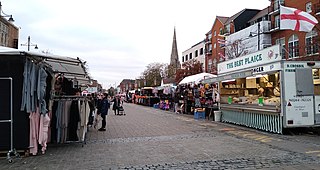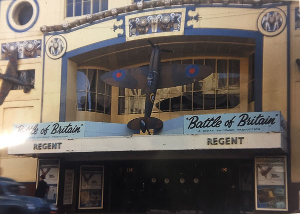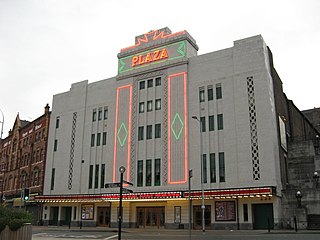
Hornchurch is a suburban town in East London in the London Borough of Havering. It is located 15.2 miles (24.5 km) east-northeast of Charing Cross. It comprises a number of shopping streets and a large residential area. It historically formed a large ancient parish in the county of Essex that became the manor and liberty of Havering. The economic history of Hornchurch is underpinned by a shift away from agriculture to other industries with the growing significance of nearby Romford as a market town and centre of administration. As part of the suburban growth of London in the 20th century, Hornchurch significantly expanded and increased in population, becoming an urban district in 1926 and has formed part of Greater London since 1965. It is the location of Queen's Theatre, Havering Sixth Form College and Havering College of Further and Higher Education.

Romford is a large town in East London, England, 14 miles (23 km) northeast of Charing Cross. Part of the London Borough of Havering, the town is one of the major metropolitan centres of Greater London identified in the London Plan.

Romford Market is a large outdoor retail market located in Romford in the London Borough of Havering, England. The market right was established by royal order in 1247. Rival markets are prohibited within 6.66 miles (10.72 km). Governance of the market was strengthened by the 1465 charter of the Liberty of Havering, which was administered from a court house at the western end of the market. Formerly a livestock and agricultural market, cattle was last sold in 1958. The market has been in local authority ownership since it was purchased by the Romford Local Board in 1892 and is now owned by Havering Council. The marketplace was located on the main east–west road through the town until traffic was diverted away from the market in 1969. The market is promoted as a filming location. It is open on Wednesday, Friday and Saturday. There was a Sunday market from July 2020 to March 2024. As of July 2020 it has 60 licensed traders, down from a peak of over 300.

The Queen's Theatre is a 507-seat mid-scale producing theatre located in Hornchurch in the London Borough of Havering, east London.

The Point is an entertainment complex in Central Milton Keynes, Buckinghamshire, England. When it opened in 1985, it was called the UK's first multiplex cinema although the UK had introduced multi-screen cinemas in 1930 and had been increasing the number of screens in cinemas ever since. The front part of the building has a distinctive mirrored crystal ziggurat shape, framed by external steel beams at each corner, joined at the apex. Originally it had red neon lights connecting the apexes at each side, so that it looked like a pyramid at night.

The Regent Cinema was a cinema in Brighton, England. It was opened by Provincial Cinematograph Theatres on 27 July 1921 and was one of that company's first super cinemas. It was demolished in 1974.

The Mercury Mall is an enclosed shopping centre in Romford town centre, in the London Borough of Havering, Greater London. It opened in June 1990 as Liberty 2. From 2006 to August 2010 it was owned by The Mall Fund and was known as The Mall Romford. It is—along with The Liberty and The Brewery—one of the three main shopping centres in Romford.

The Plaza is a Grade II* listed art deco single-screen cinema and theatre in Stockport, Greater Manchester, England. It opened in 1932, its construction having involved the excavation of the sandstone cliff behind it. After an initial closure in 1966 and a subsequent period in use as a bingo hall by Rank Leiure, it has now been restored as a cinema and theatre, showing films and staging live shows.
Cape Hill is an area of Smethwick, in the Metropolitan Borough of Sandwell, West Midlands, England, 2+3⁄4 miles (4.4 km) west of Birmingham City Centre. The area includes Waterloo Road near Shireland Collegiate Academy and the High Street near Victoria Park; it borders Birmingham at the A457 Dudley Road. Cape Hill is Smethwick's busiest shopping area.
Orchard Village, formerly known as the Mardyke Estate, is a housing development in the South Hornchurch area of London, England.

Leslie H. Kemp and Frederick E. Tasker were English architects who practiced in the 1930s as Kemp & Tasker.

John Stanley Coombe Beard FRIBA, known professionally as J. Stanley Beard, was an English architect known for designing many cinemas in and around London.
Bradford Odeon is the name applied to two different cinemas in central Bradford, West Yorkshire, England. One, in Godwin Street, was built in 1930 and survives; the other, in Manchester Road, was built in 1938 and demolished in 1969.

The Odeon at Kingstanding, Birmingham, was a 1930s cinema in the Odeon chain. Though closed as a cinema in 1962, the building survives as a bingo hall, and is Grade II listed.

The Embassy Cinema is a former cinema in the town of Chadwell Heath, Greater London. It was once known, among locals, as The Gaumont. It was designed in an art deco style, with a streamline moderne interior, by Harry Weston in 1934. The building is situated on the border of Redbridge and Barking & Dagenham, in the Chadwell Heath District Centre. The cinema closed in 1966 and became a Bingo Hall. In 2015, following the closure of the Bingo Hall, it was then used as a wedding hall/banqueting suite. The building was listed as an Asset of Community Value by the 'Chadwell Heath South Residents' Association' in August 2017 and is currently the focus of a major cinema restoration project.

The George Cinema is a former Art Deco cinema on Bath Street in Portobello, Edinburgh. The building opened in 1939 as the County Cinema. For many years, a bingo hall, it is a Category C listed building.

The Ace Cinema, originally the Grosvenor Cinema and now known as the Zoroastrian Centre, is a Grade II* listed Art Deco former cinema in Rayners Lane in the London Borough of Harrow.

Scott Cinema was a cinema in Bridgwater, Somerset England. Built in 1936, it was notable for its Art Deco style.

The Vogue Cinema Possil is situated on 124 Balmore Road, Possilpark in the north of Glasgow, Scotland.

















